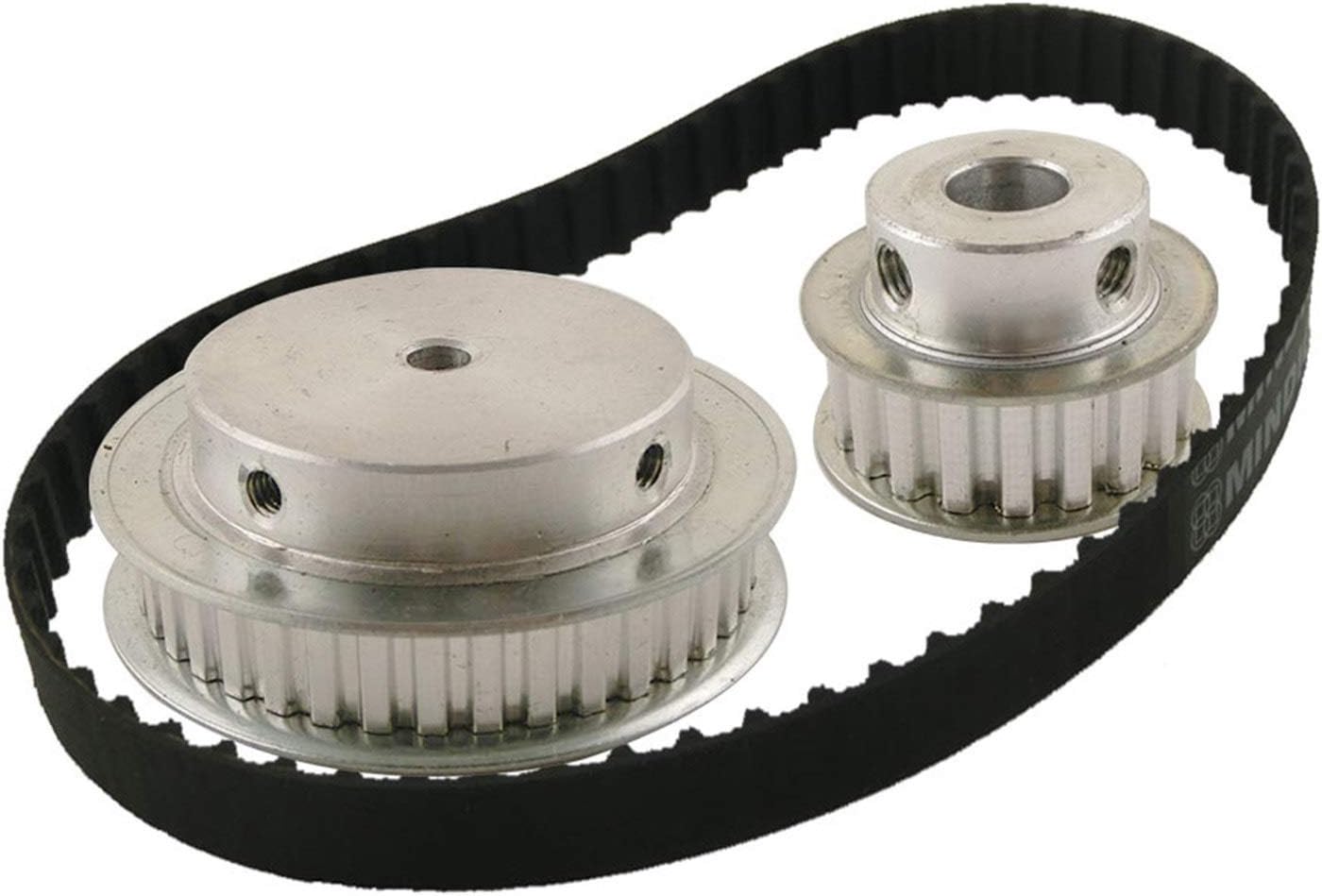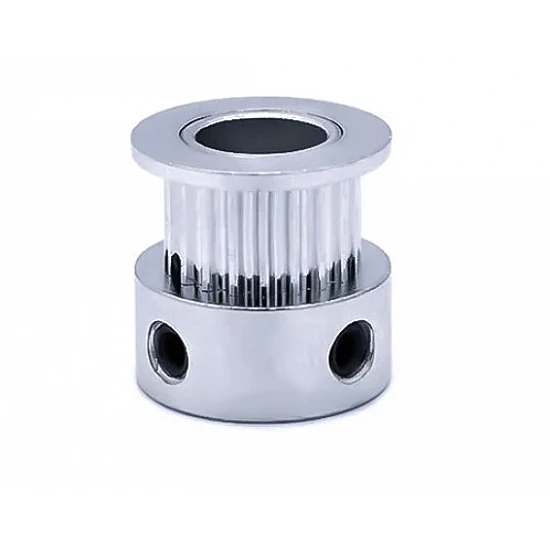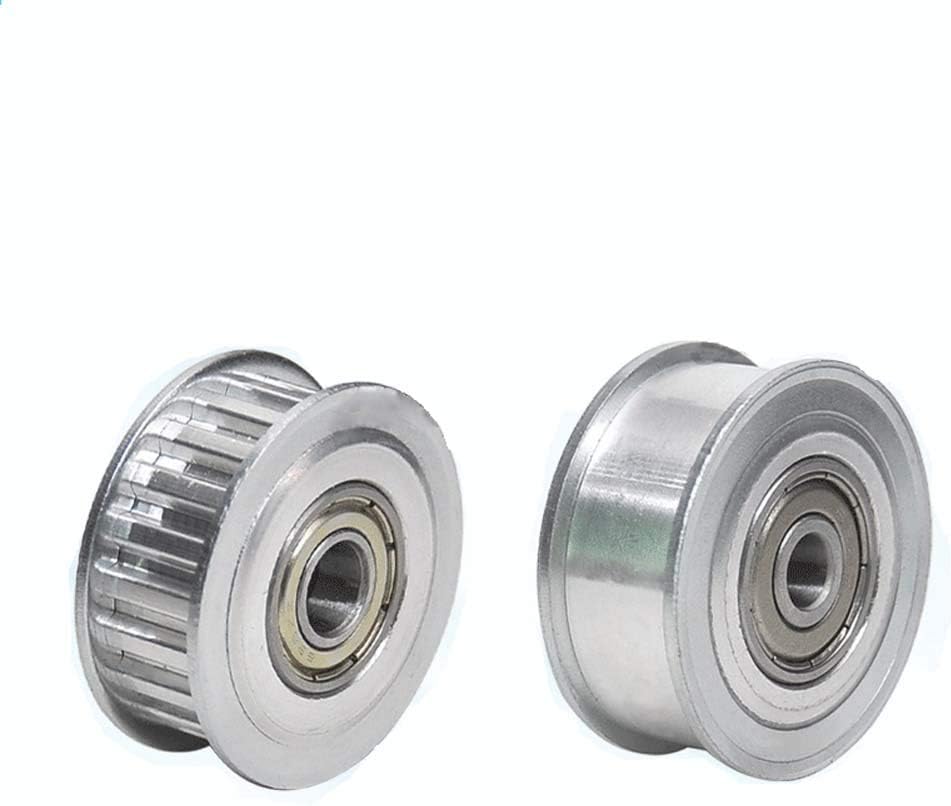Product Description
Product Description
1.Teeth Profile:
|
HTD: |
3M,5M,8M,14M,20M |
|||
|
T&AT: |
T2.5,T5,T10, AT5,AT10,AT20 |
|||
|
STPD: |
S2M,S3M,S4.5M,S5M,S8M,S14M |
|||
|
RPP: |
5M,8M,14M,20M |
|||
|
PGGT (PowerGrip GT): |
2MR,3MR,5MR,8MR,14MR |
|||
2. Materials:
Aluminum timing pulleys
Characteristics:
1.suitable for moderate power transmission
2.light weight / reduced rotational inertia
3.moderate chemical and corrosion resistance
4.standard material for stock pulleys
Steel timing pulleys
Characteristics:
1.suitable for high power transmission
2.durable
3.limited chemical and corrosion resistance
4.aesthetic material
3.Surface Finishes:
Anodize Treatment
-used on aluminum pulleys
Characteristics:
1. Increased chemical and corrosion resistance
2. Available in natural, black, or colored
3. Limited increase of surface hardness
4. Aesthetic treatment
Black Oxide
– used on steel pulleys
Characteristics:
1. Increased chemical and corrosion resistance
2. Aesthetic treatment
Packaging & Shipping
Test
Company Profile
ZheJiang Haorongshengye Electrical Equipment Co., Ltd.
1. Was founded in 2008
2. Our Principle:
“Credibility Supremacy, and Customer First”
3. Our Promise:
“High quality products, and Excellent Service”
4. Our Value:
“Being Honesty, Doing the Best, and Long-lasting Development”
5. Our Aim:
“Develop to be a leader in the power transmission parts industry in the world”
|
6.Our services: |
1).Competitive price |
|||
|
2).High quality products |
||||
|
3).OEM service or can customized according to your drawings |
||||
|
4).Reply your inquiry in 24 hours |
||||
|
5).Professional technical team 24 hours online service |
||||
|
6).Provide sample service |
||||
Main products
Machines
Exbihition
| Manufacturing Process: | Hobbing |
|---|---|
| Material: | Carbon Steel |
| Surface Treatment: | Polishing |
| Application: | Chemical Industry, Grain Transport, Mining Transport, Power Plant |
| Teeth Number: | 8-100t |
| Type for Arc Tooth: | 3m/5m/8m/14m/S3m/S5m/S8m |
| Samples: |
US$ 100/Piece
1 Piece(Min.Order) | |
|---|
| Customization: |
Available
| Customized Request |
|---|

What is the significance of precision machining in XL pulley manufacturing?
Precision machining plays a crucial role in XL pulley manufacturing, offering several significant benefits. Here is a detailed explanation of the significance of precision machining in XL pulley manufacturing:
1. Accurate Dimensional Control:
Precision machining ensures accurate dimensional control in the manufacturing process of XL pulleys. The precise shaping and machining of the pulleys’ components, such as the hub, bore, and tooth profile, guarantee the correct fit and alignment with other components in the power transmission system. Accurate dimensional control results in smooth and efficient operation of the pulleys.
2. Consistent Tooth Profile:
Precision machining allows for the consistent production of the tooth profile on XL pulleys. The teeth on the pulleys must have precise shapes and dimensions to properly engage with the teeth of the timing belt, ensuring reliable power transmission. Consistency in tooth profile eliminates irregularities or variations that could lead to belt slippage, premature wear, or reduced system efficiency.
3. High Surface Quality:
Precision machining techniques produce XL pulleys with high surface quality. The smooth and polished surfaces of the pulleys reduce friction and wear, contributing to improved efficiency and prolonged belt life. High surface quality also minimizes noise, vibrations, and the risk of debris accumulation, ensuring smooth and reliable operation in various industrial applications.
4. Tight Tolerances:
Precision machining allows for the production of XL pulleys with tight tolerances. Tight tolerances ensure close adherence to specified dimensions and performance requirements. The precise alignment of pulley components, such as the bore and keyway, with the shaft guarantees a secure and accurate fit. Tight tolerances enhance the pulley’s overall performance, reliability, and compatibility with other system components.
5. Customization Capabilities:
Precision machining enables the customization of XL pulleys to meet specific application requirements. Manufacturers can easily modify the pulley’s design, dimensions, or features to tailor it for unique industrial needs. Precision machining techniques facilitate the production of custom pulleys with precise specifications, ensuring optimal performance and compatibility with the intended application.
6. Efficient Production Process:
Precision machining techniques, such as computer numerical control (CNC) machining, offer efficient and automated processes for XL pulley manufacturing. CNC machines can produce pulleys with high accuracy and repeatability, reducing human errors and ensuring consistent quality. The efficient production process enabled by precision machining results in cost-effective manufacturing, shorter lead times, and increased production capacity.
In summary, precision machining is of significant importance in XL pulley manufacturing due to its ability to achieve accurate dimensional control, consistent tooth profile, high surface quality, tight tolerances, customization capabilities, and efficient production processes. These factors contribute to the overall performance, reliability, and compatibility of XL pulleys in various industrial applications.

How does the tooth profile of XL pulleys contribute to their performance?
The tooth profile of XL pulleys plays a crucial role in determining their performance in power transmission systems. Here’s a detailed explanation of how the tooth profile contributes to their performance:
1. Efficient Power Transmission:
The tooth profile of XL pulleys is designed to engage with the corresponding teeth on the timing belt. This positive engagement ensures efficient power transmission by minimizing slippage and maximizing the transfer of rotational motion. The tooth profile allows for a large contact area between the pulley and the belt, enabling effective torque transfer and minimizing energy losses.
2. Accurate and Repeatable Positioning:
The tooth profile of XL pulleys enables accurate and repeatable positioning in motion control systems. The teeth on the pulley mesh precisely with the teeth on the timing belt, providing precise angular displacement and positioning control. This tooth engagement allows for reliable and consistent positioning, making XL pulleys suitable for applications that require high positional accuracy, such as robotics and CNC machines.
3. Reduced Backlash:
The tooth profile of XL pulleys helps reduce backlash, which is the play or clearance between the teeth of the pulley and the belt. Backlash can introduce inaccuracies and vibrations in the power transmission system. The tooth profile of XL pulleys minimizes backlash by ensuring a close fit with the timing belt teeth, resulting in smoother operation, improved precision, and reduced mechanical vibrations.
4. Load Distribution:
The tooth profile of XL pulleys allows for effective load distribution along the width of the belt. As torque is transmitted from the pulley to the belt, the tooth profile ensures that the load is evenly distributed across the belt’s width. This load distribution helps prevent concentrated stress points and excessive wear on specific areas, leading to improved durability and longevity of the pulley and belt.
5. Noise Reduction:
XL pulleys with well-designed tooth profiles contribute to reduced noise levels during operation. The tooth engagement and smooth meshing between the pulley and the timing belt minimize vibration and noise generation. This advantage is particularly important in applications that require low noise levels, such as medical equipment, office machinery, and audiovisual systems.
Overall, the tooth profile of XL pulleys significantly impacts their performance by enabling efficient power transmission, precise positioning, reduced backlash, even load distribution, and noise reduction. Manufacturers carefully design the tooth profiles of XL pulleys to optimize these performance characteristics for various applications and operating conditions.

What materials are typically used in the construction of XL pulleys?
The construction of XL pulleys involves the use of various materials, depending on the specific application requirements, load capacity, and cost considerations. Here are the materials commonly used in the construction of XL pulleys:
1. Aluminum:
Aluminum is a lightweight and corrosion-resistant material commonly used in XL pulleys. It offers good strength-to-weight ratio and excellent machinability, making it suitable for many applications. Aluminum pulleys are often used in robotics, automation systems, and other applications where weight reduction is desirable.
2. Steel:
Steel is a durable and robust material used in XL pulleys for applications that require higher load capacity and strength. Steel pulleys provide excellent resistance to wear and can handle heavy-duty applications. They are commonly used in industrial machinery, automotive components, and other demanding applications.
3. Plastic:
Plastic pulleys are lightweight, cost-effective, and offer good resistance to chemicals and corrosion. They are commonly made from materials such as nylon, acetal, or polycarbonate. Plastic pulleys are used in a variety of applications, including 3D printers, medical devices, and smaller-scale machinery.
4. Composite Materials:
Composite materials, such as fiberglass-reinforced polymers, are sometimes used in the construction of XL pulleys. These materials offer a combination of properties, including high strength, low weight, and resistance to corrosion. Composite pulleys are often used in aerospace, marine, and other specialized applications.
5. Stainless Steel:
Stainless steel is chosen for XL pulleys when corrosion resistance is of utmost importance. Stainless steel pulleys exhibit excellent resistance to rust and corrosion, making them suitable for applications in harsh environments or where exposure to moisture or chemicals is expected.
It’s important to note that the material selection for XL pulleys depends on factors such as the application requirements, load capacity, environmental conditions, and budget constraints. Manufacturers consider these factors to determine the most suitable material for achieving the desired performance and reliability in specific applications.


editor by CX
2023-10-23
